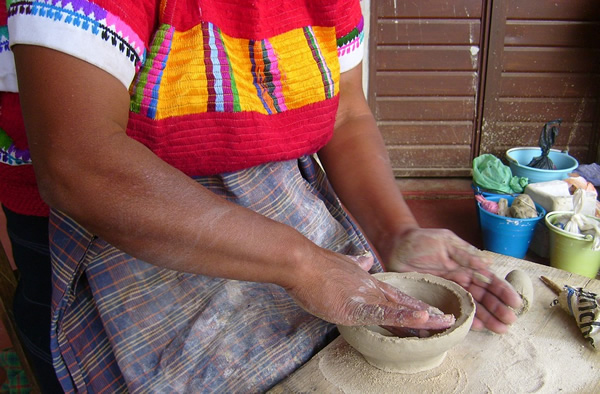|
Building Casas with the Habitat for Humanity
Work Side by Side as a Volunteer with Villagers in Chiapas, Mexico
by Kara Shane Colley

|
|
Traditional pottery being made by a woman in Chiapas.
|
As volunteers for Habitat for Humanity in Chiapas, Mexico, my husband Sky and I worked for two-and-a-half weeks in Candelaria, a Chamula village in the mountains outside of San Cristobal de Las Casas. Our schedule was left up to us so we chose to work and live for four days in the mountains, then take two days off to spend in the city. Who we worked for and where we would sleep and eat was left up to the community of eight families constructing houses in Candelaria with Habitat.
Each day we started at about 7 a.m. and worked for about two hours before stopping for breakfast. Breakfast was no different from comida, the big meal of the day. At both meals, we ate tortillas and beans with rice, pasta, greens, potatoes, or eggs, always served with a common bowl of salt and dried chiles and a pitcher of Kool-Aid. At noon, the mom of the house brought us pozol, a drink made of ground-up corn and water. At around 3 p.m., we ate comida, and then continued to work until 4 or 5 p.m. At about 7 p.m., we ate a light supper, usually tortillas, beans, eggs, and coffee.
The work was hard and the sun was hot. After the first stretch of four days, my back, arms, and legs were aching, and my neck and nose were sunburned. Our jobs included shoveling dirt to fill in the foundations, digging holes to insert posts, carrying cinder blocks from one pile to another pile, twisting wire to make rebar posts, and the best of them all: mixing cement by hand. On both construction sites the workers were all men, while the women were in charge of the meals.
I felt a bit strange at first, being the only women on the crew, but I got over it when I saw that my work was just as appreciated as anyone else’s. The construction of the two houses progressed extremely fast. When we arrived, German and Manuel’s houses only had foundations. When we left two-and-a-half weeks later, German’s house had a roof, and Manuel’s house was nearly ready for the roof to be poured.
An experience with Habitat is not just about constructing houses. As tourists, it would have been nearly impossible to become acquainted with the people of Candelaria and their way of life. Habitat was the key that unlocked this village for us. We spent a few evenings talking with Sebastiana, German’s wife, in the dirt-floor kitchen, while she cooked our dinner over an open flame. The grandmother, wearing the typical Chamula skirt, a handmade black wool blanket wrapped around her, did not speak any Spanish. The most we could do was smile at her and admire her technique for making tortillas and wonder how many she had made in her life. She always wore her hair in long braids tied together in the back with a colorful ribbon and walked barefoot.
About one in three men we met in Candelaria had been to the United States, crossing the border illegally. The men clearly viewed us as rich Americans and America as a money-filled paradise. This experience put a human face on the complicated issue of immigration.
During this experience, I learned that I agree with Habitat’s ideals, even more than I originally thought. Habitat provides the materials for the house, the people in the community build the house themselves (with foreigners coming to help sometimes), and then the people pay back the cost of the materials over five to 10 years. Basically, Habitat gave them an interest-free loan. Both families said that they would never have been able to build a house without Habitat.
Kara Shane Colley and her husband Sky returned from a 5-month long trip in Mexico. She is now volunteering on the Halfmoon, a replica of Henry Hudson’s 17th century ship, while planning her next overseas adventure.
|
